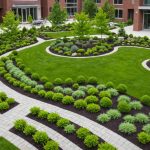Importance of Eco-Friendly Landscaping in Urban Development
Eco-friendly landscaping plays a vital role in urban development, promoting numerous advantages. This approach helps to enhance biodiversity by fostering various plant species, attracting diverse insect and animal populations. As ecosystems thrive, they offer essential services, such as pollination and air purification, which are crucial for urban health.
Incorporating eco-friendly practices also directly tackles the pressing issue of urban heat islands. Through increasing green spaces and vegetation, cities can effectively alleviate heat accumulation, making the environment cooler and more bearable for residents. These benefits extend to improving energy efficiency in buildings, as greenspaces moderate temperatures, reducing the need for artificial cooling.
Also to read : Essential Strategies for Navigating Property Development Within UK Green Belt Regions
Additionally, eco-friendly landscaping significantly contributes to the sustainability of urban areas. It aids in stormwater management, reducing runoff and flooding while conserving water through drought-resistant plants and smart watering systems. This sustainable approach not only preserves natural resources but also enhances urban aesthetics, making places more pleasant and inviting.
By focusing on eco-friendly practices, urban planners can ensure that cities evolve in harmony with nature. This creates vibrant, sustainable environments that serve the needs of their communities while protecting the broader ecosystem. Embracing such practices is crucial for fostering resilient urban spaces.
In parallel : Top Insulation Strategies for Coastal UK Homes: Protecting Against Salt Corrosion
Key Strategies for Sustainable Landscaping
When considering sustainable landscaping strategies, it’s essential to employ innovative methods that promote environmental health and resource efficiency. One effective approach is integrating green infrastructure into urban design, such as green roofs and walls. These not only enhance building aesthetics but also improve insulation, reduce stormwater runoff, and support biodiversity.
Another critical strategy is the use of permeable paving materials. Unlike traditional surfaces, permeable pavements allow water to infiltrate the ground, diminishing flooding risks and replenishing groundwater supplies. This eco-friendly solution is both practical and effective.
Furthermore, incorporating water-efficient irrigation systems is a vital part of sustainable landscaping. These systems, often equipped with smart technology, optimize water usage by delivering the precise amount needed for plant growth, thereby conserving water resources and lowering utility costs.
These design practices are multifaceted and address various environmental challenges, ultimately contributing to a more sustainable and resilient ecosystem. By embracing sustainable landscaping, communities can enjoy the benefits of a healthier environment while also enhancing their urban landscapes.
Native Plants and Their Benefits
Native plants play a critical role in promoting biodiversity and enhancing landscape resilience. These plants are inherently suited to their local environment, which means they thrive with minimal human intervention. As a result, they naturally resist pests and diseases common in their ecosystems.
Advantages of Native Plant Species
Native plants are perfectly adapted to the local climate and soil conditions, ensuring their survival even in harsh weather. This adaptation reduces the need for artificial irrigation and fertilisers, thus conserving resources.
Moreover, they provide essential support for local wildlife, including pollinators like bees and butterflies. These plants form symbiotic relationships with local fauna, offering food and habitat, crucial for maintaining ecological balance.
Another advantage is the reduced maintenance native plants require. Unlike non-native species, they do not demand excessive watering or chemical inputs. This not only eases landscape maintenance but also lessens environmental impact.
Successful Case Studies
Urban projects increasingly showcase the successful use of native species. By analysing plant selection and positioning, these initiatives demonstrate how native plants uplift cityscapes without compromising on aesthetics. Implementations teach valuable lessons on flexibility and creativity in urban planning.
Overcoming Challenges
Educating the public is key to overcoming misconceptions about native plants. Many people still view them as unruly or unappealing. Efforts to demonstrate the beauty and practicality of native landscapes can help shift these opinions. Finding suitable native species for diverse urban settings involves understanding local ecosystems and making informed choices. Engaging communities through workshops and informational sessions can disseminate knowledge and generate enthusiasm for native planting.
Policies and Regulations Supporting Eco-Friendly Practices
Numerous urban policies and sustainability regulations have been enacted to promote eco-friendly practices across cities and countries. By reinforcing specific measures, these policies aim to address pressing environmental challenges and support sustainable development.
At the local level, municipalities are increasingly implementing zoning and land-use planning measures. These frameworks shape the development of urban spaces, ensuring that new projects meet sustainability standards. By dictating land usage, cities can balance the needs for economic growth with environmental conservation.
On a broader scale, national policies often provide the backbone for local actions. By setting ambitious targets and guidelines, these policies foster a unified effort towards sustainability. They encourage cities to innovate and adopt best practices that align with global environmental goals.
Incentives play a crucial role in encouraging developers to incorporate green initiatives. Financial perks, such as tax breaks or grants, are often offered to those who meet certain eco-friendly criteria. This not only benefits the environment but also attracts developers interested in sustainable projects. Ultimately, these plans showcase the value of collaboration between governments, developers, and communities in achieving environmental goals.
Tools and Resources for Implementation
Embarking on a sustainable landscaping project requires access to the right tools and educational resources. There is a notable collection of landscaping design software that empowers both professionals and hobbyists to visualize and plan effective landscapes. These platforms provide users the ability to simulate different plant placements and experiment with sustainable design layouts before implementing their plans in reality.
Incorporating native plant species is another critical aspect. Access to native plant nurseries and suppliers is invaluable for landscapers aiming to create environmentally-friendly outdoor spaces. Selecting local flora enhances biodiversity, requires less water, and typically withstands local pests and climatic conditions better than non-native options.
For urban planners and landscapers, educational resources are abundant. Numerous online courses and workshops detail the integration of sustainable design practices into urban settings. These resources not only offer comprehensive planting guides but also emphasize the importance of maintaining eco-friendly landscapes.
By leveraging these tools and accessing these resources, landscapers and urban planners are well-equipped to craft spaces that are both visually appealing and environmentally responsible.
Expert Insights and Interviews
Exploring the world of landscaping and sustainability involves engaging with a diverse range of expert opinions. Professionals from various fields contribute invaluable insights, highlighting the importance of innovation and collaboration.
Interviews with Landscape Architects
Landscape architects offer a unique perspective on innovative solutions. They focus on sustainable practices that integrate seamlessly into urban environments. Challenges include balancing aesthetic values with functional requirements in cities.
In recent urban projects, architects face hurdles such as limited space and strict environmental regulations. Despite these challenges, there is optimism. Eco-friendly landscaping is emerging as a key trend. Experts anticipate future developments will incorporate more green technologies and sustainable materials, further shaping urban landscapes.
Collaborations with Sustainability Experts
Collaboration is central to achieving sustainability goals. Interdisciplinary approaches allow professionals from architecture, ecology, and engineering to work together. These partnerships enhance urban development.
The importance of these collaborations cannot be overstated. By working together, professionals achieve greater results, sharing success stories that inspire further action. Sustainability experts emphasize that partnerships are essential for progress.
Through shared insights and expertise, the landscape of urban development is constantly evolving. The focus remains on forward-thinking solutions fostering eco-friendly practices.











